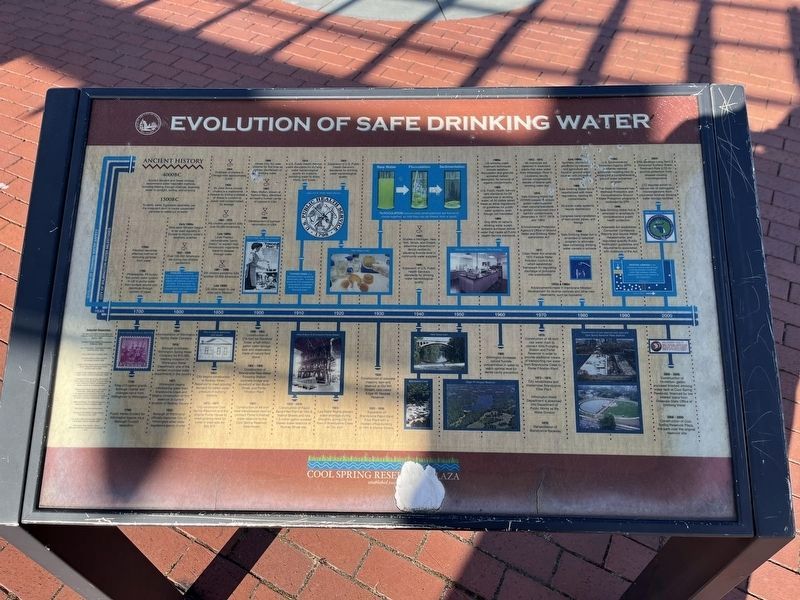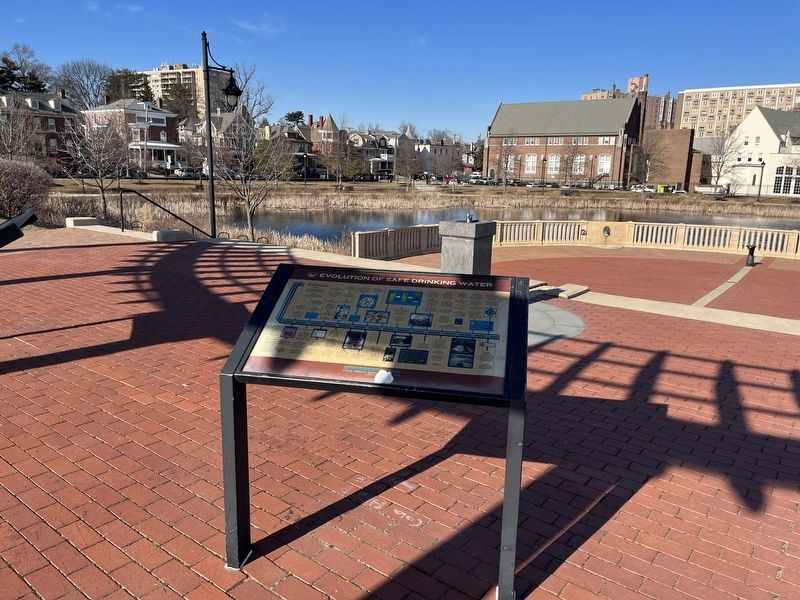Cool Spring in Wilmington in New Castle County, Delaware — The American Northeast (Mid-Atlantic)
Evolution of Safe Drinking Water
Cool Spring Reservoir Plaza
— established 2009 —

Photographed By Devry Becker Jones (CC0), February 10, 2023
1. Evolution of Safe Drinking Water Marker
Ancient History
4000 BC
Ancient Sanskrit and Greek writings recommend water treatment methods, including filtering through charcoal, exposing water to sunlight, boiling, and straining.
1500 BC
To clarify water, Egyptians reportedly use the coagulant alum to cause suspended particles to settle out of water.
1700
Evolution of Drinking Water Safety
1700s:
Filtration becomes effective method of removing particles from water.
1799:
Philadelphia, PA builds first public water system in US to pump water from surface source and distribute through system of pipes.
City of Wilmington Water Milestones
1739:
King of England grants borough charter and changes name from Willingtown to Wilmington.
1796:
Public Works System for Wilmington begins via a Borough Council resolution.
1800
Evolution of Drinking Water Safety
Early 1800s:
Slow sand filtration begins to be used regularly in Europe to improve water's aesthetic qualities.
1832 - 1849:
Over 150,000 Americans die during two cholera pandemics.
Cholera is a serious infectious disease caused by the bacteria Vibrio cholerae, which affects the intestinal system of the body. It is spread by the unintentional consumption of infected feces that contaminate food and water.
City of Wilmington Water Milestones
1804:
Incorporation of Wilmington Spring Water Company.
1810:
Borough purchases Wilmington Spring Water Company for $10,000, marking inception of Wilmington Water Department, one of the earliest municipal water departments in the country.
1827:
Wilmington begins withdrawing water from Brandywine Creek and begins construction of first reservoir at current location of Rodney Square.
1832:
Borough of Wilmington officially becomes City of Wilmington when state legislature grants charter.
1850
Evolution of Drinking Water Safety
1854:
Outbreak of cholera in Chicago kills approximately 3,500.
1855:
Dr. John Snow proves cholera is a waterborne disease by linking outbreak of illness in London to public well contaminated by sewage.
1863 - 1875:
4th cholera pandemic kills over 50,000 Americans.
Late 1880s:
Louis Pasteur demonstrates "germ theory" to explain microscopic organisms transmit disease through water.
1881 - 1896:
5th cholera pandemic

Photographed By Devry Becker Jones (CC0), February 10, 2023
2. Evolution of Safe Drinking Water Marker
Late 1800s: US cities begin to use slow sand filtration.
City of Wilmington Water Milestones
1863:
City begins construction of Rodney Street Reservoir to meet growing demand for better water pressure in outlying districts.
1873 - 1877:
City constructs Cool Spring Reservoir and the original Pump House to meet growing need for water in west side for $56,875.
1900
Evolution of Drinking Water Safety
1908:
Jersey City, NJ uses chlorine for first time as primary disinfectant of drinking water.
1907:
Mary Mallon, known as Typhoid Mary, identified as healthy human carrier of typhoid in USA.
1909:
Development of typhoid vaccination in USA.
06/20/1909: New York American news article 'Typhoid Mary'
City of Wilmington Water Milestones
1899 - 1902:
Construction of 115-foot tall Rockford Tower, a half million gallon water storage tank and observatory made of natural field stone.
1902 - 1909:
Construction of Brandywine Raw Water Pumping Station, concrete bridge and aqueduct at Van Buren Street, and Porter Filtration Plant.
1907:
Construction of 48-inch steel transmission main to connect Porter's finished water reservoir to the Cool Spring Reservoir Gate House.
1910
Evolution of Drinking Water Safety
1914:
U.S. Public Health Service sets standards for drinking water bacteriological quality for systems providing water to ships, trains, and buses.
Typhoid fever is a baterial illness caused by Salmonella typhi. It is also spread by the unintentional consumption of infected feces that contaminates food and water.
City of Wilmington Water Milestones
1915 - 1919:
Construction of Rapid Sand Filter Plant at 16th and Walnut Streets and new 7.5-million gallon covered filtered water reservoir at Rodney Street site.
1920
Evolution of Drinking Water Safety
1925:
Expansion of U.S. Public Health Service's standards for drinking water bacteriological quality.
City of Wilmington Water Milestones
1923:
Lea Water Rights prevent water shortage during droughts, giving City full flow of Brandywine Creek at City dam.
1930
Evolution of Drinking Water Safety
Flocculation occurs when small particles are forced to clump together, so that they can be filtered from a liquid.
City of Wilmington Water Milestones
1932:
Construction of concrete masonry dam and reservoir at Old Mill Stream, now called Edgar M. Hoopes Reservoir.
1933 - 1934:
Expansion of Brandywine Rapid Sand Filter Plant with a modern office building at 16th & Market Streets.
1940
Evolution of Drinking Water Safety
1945:
Studies in Michigan, New York, Illinois, and Ontario determine prevention of dental cavities by adjusting fluoride level in community water supplies.
1946:
Expansion of U.S. Public Health Service's standards for drinking water bacteriological quality.
1950
1960
Evolution of Drinking Water Safety
1960s:
US drinking water treatment techniques include aeration, flocculation and granular activated carbon absorption for removal of organic contaminants.
1962:
U.S. Public Health Service sets standards for 28 substances in drinking water; all 50 states adopt these as either regulations or guidelines for public water systems, even though not mandated.
1969:
Only 60% of nation's drinking water supply systems surveyed deliver water that meets all Public Health Service standards.
City of Wilmington Water Milestones
1960:
Wilmington increases natural fluoride concentration in water to reach optimal level for dental cavity prevention.
1970
Evolution of Drinking Water Safety
1972 - 1973:
36 chemicals are detected in treatment plants that draw water from Mississippi River in Louisiana, results prompt congressional debate of safe drinking water law.
1974:
Safe Drinking Water Act (SDWA) passes to ensure public water supplies meet national standards to protect consumers from harmful contaminants (Amended in 1977, 1979, and 1980).
Environmental Protection Agency's Office of Ground Water and Drinking Water administers Act.
1977:
Clean Water Act amends 1972 Federal Water Pollution Control Act, which establishes framework for regulating discharge of pollutants into waterbodies.
1970s & 1980s:
Advancements made in membrane filtration development for reverse osmosis and other new treatments, such as ozonation.
City of Wilmington Water Milestones
1970:
Construction of 48-inch raw water main to connect Wills Pumping Station and Porter Reservoir in order to provide additional means of transporting raw water from Brandywine Creek to Porter Filtration Plant.
1973 - 1974:
City rehabilitates and modernizes Brandywine Filter Plant.
Wilmington Water Department is absorbed into Department of Public Works as the Water Division.
1978:
Rehabilitation of Brandywine Raceway.
1980
Evolution of Drinking Water Safety
Early 1980s:
Synthetic chemicals produced by industry and agriculture are found in ground water sources with increased frequency.
1986:
Safe Drinking Water Act is reauthorized with more regulations, naming 83 contaminants.
All public water systems require disinfections.
Congress bans installation of led solder, pipes, and fittings.
1988:
Safe Drinking Water Act is amended to establish program to eliminate lead-containing drinking water coolers in schools.
City of Wilmington Water Milestones
Construction of new reservoir tank (top) and Cool Spring Reservoir Plaza (bottom).
1990
Evolution of Drinking Water Safety
1992:
U.S. Environmental Protection Agency (EPA) publishes national guidelines detailing how to implement a comprehensive ground water protection program.
The State of Delaware has Wellhead Protection and Comprehensive Ground Water Protection programs endorsed by EPA.
1996: Safe Drinking Water Act is amended to emphasize comprehensive public health protection.
Amended Act establishes Consumer Confidence Reports and Source Water Assessments, and stipulated specific Public Notification guidelines and requirements associated with violations of the Act.
Reverse Osmosis is the process of forcing water through a semipermeable membrane under high pressure, leaving solutes behind on the surface of the membrane.
2000
Evolution of Drinking Water Safety
2003:
EPA develops Long Term 2 Enhanced Surface Water Treatment Rule (LT2) to provide protection from disease-causing microorganisms.
LT2 requires actions to reduce risk of pathogenic microorganisms from uncovered finished drinking water storage facilities.
City of Wilmington Water Milestones
2005 - 2008:
Construction of 10-million- gallon enclosed finished drinking water tank at Cool Spring Reservoir, financed by low interest loans from Delaware State Office of Drinking Water.
2008 - 2009: Construction of Cool Spring Reservoir Plaza, the park over the original reservoir site.
Erected 2009 by City of Wilmington, Delaware.
Topics. This historical marker is listed in these topic lists: Charity & Public Work • Colonial Era • Environment • Industry & Commerce • Natural Resources • Parks & Recreational Areas • Science & Medicine • Waterways & Vessels.
Location. 39° 45.075′ N, 75° 33.547′ W. Marker is in Wilmington, Delaware, in New Castle County. It is in Cool Spring. Marker can be reached from the intersection of North Franklin Street and West 11th Street, on the right when traveling north. Touch for map. Marker is at or near this postal address: 1013 N Franklin St, Wilmington DE 19806, United States of America. Touch for directions.
Other nearby markers. At least 8 other markers are within walking distance of this marker. Science in Action (here, next to this marker); Vegetative Pond Buffer / Amortiguador de Estanque Vegetativo (within shouting distance of this marker); A City’s Growing Demand for Water (within shouting distance of this marker); A City Park Is Born (within shouting distance of this marker); The Pump House and Gate House (within shouting distance of this marker); Meadow / El Prado (within shouting distance of this marker); Stormwater Planters / Jardineras De Aguas Pluviales (about 400 feet away, measured in a direct line); Cool Spring Park (about 500 feet away). Touch for a list and map of all markers in Wilmington.
Credits. This page was last revised on February 12, 2023. It was originally submitted on February 12, 2023, by Devry Becker Jones of Washington, District of Columbia. This page has been viewed 86 times since then and 23 times this year. Photos: 1, 2. submitted on February 12, 2023, by Devry Becker Jones of Washington, District of Columbia.